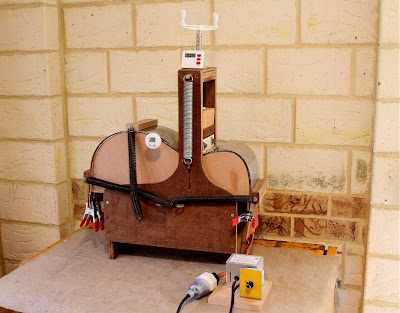After installing purflings and bindings, it's very rewarding to scrape them level, carefully round over the edges, then sand the top, back and sides in readiness for the first steps in the finishing process. It feels like the end of a journey while at the same time signifying the beginning of another equally challenging one.
With final sanding on this guitar complete, I've taken the first steps towards pore-filling the back and sides with epoxy, a process that finally reveals the true beauty of the wood. As a hobby builder, many months have inevitably elapsed before I get to this stage, but the rewards make the effort and the wait worthwhile. Along with stringing a completed guitar up for the first time, seeing the figure and colour of the wood magically appear as the first coat of epoxy is applied is surely one of the highlights of the building process.
On a cautionary note, a problem with some epoxies is that of amine blush, a waxy residue that forms as the epoxy cures that can interfere with adhesion and curing of subsequent top coats. From what I've read on the topic, spending a little more on a good quality epoxy is worth considering as they're less likely to be susceptible to blushing. Whichever product you choose, once the epoxy has fully cured a thorough rub down with a damp cloth - or, better still, one dampened with a 50/50 mixture of water and denatured alcohol - is a simple precaution that eliminates potential problems. There's wisdom too in avoiding the application of epoxy when the ambient temperature is falling and relative humidity is therefore likely to be rising - conditions said to exacerbate blushing.
Hats off to Todd Stock for putting together these very informative tutorials:
Epoxy Pore Filling Part 1: Application of First Coat & Sealing a Rosette
Epoxy Pore Filling Part 2: Prep & Application of Second Coat
Epoxy Pore Filling Part 3: Prep & Application of Third Coat and Prep for Finishing
Cheers
Pete
On a cautionary note, a problem with some epoxies is that of amine blush, a waxy residue that forms as the epoxy cures that can interfere with adhesion and curing of subsequent top coats. From what I've read on the topic, spending a little more on a good quality epoxy is worth considering as they're less likely to be susceptible to blushing. Whichever product you choose, once the epoxy has fully cured a thorough rub down with a damp cloth - or, better still, one dampened with a 50/50 mixture of water and denatured alcohol - is a simple precaution that eliminates potential problems. There's wisdom too in avoiding the application of epoxy when the ambient temperature is falling and relative humidity is therefore likely to be rising - conditions said to exacerbate blushing.
Hats off to Todd Stock for putting together these very informative tutorials:
Epoxy Pore Filling Part 1: Application of First Coat & Sealing a Rosette
Epoxy Pore Filling Part 2: Prep & Application of Second Coat
Epoxy Pore Filling Part 3: Prep & Application of Third Coat and Prep for Finishing
Cheers
Pete

















